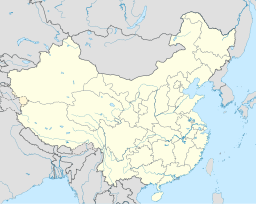Bezeklik Thousand Buddha Caves
| Bezeklik Caves | |
|---|---|

Bezeklik caves
|
|
| Location of Bezeklik Caves in China | |
| Coordinates | 42°57′21″N 89°32′22″E / 42.95583°N 89.53944°ECoordinates: 42°57′21″N 89°32′22″E / 42.95583°N 89.53944°E |
The Bezeklik Thousand Buddha Caves (Chinese: 柏孜克里千佛洞; pinyin: Bózīkèlǐ Qiānfódòng) is a complex of Buddhist cave grottos dating from the 5th to 14th century between the cities of Turpan and Shanshan (Loulan) at the north-east of the Taklamakan Desert near the ancient ruins of Gaochang in the Mutou Valley, a gorge in the Flaming Mountains, China. They are high on the cliffs of the west Mutou Valley under the Flaming Mountains, and most of the surviving caves date from the West Uyghur kingdom around the 10th to 13th centuries.
There are 77 rock-cut caves at the site. Most have rectangular spaces with rounded arch ceilings often divided into four sections, each with a mural of the Buddha. The effect is of entire ceiling covers with hundreds of Buddha murals. Some murals show a large Buddha surrounded by other figures, including Turks, Indians and Europeans. The quality of the murals vary with some being artistically naive while others are masterpieces of religious art. The murals that best represent the Bezeklik Thousand Buddha Caves are the large-sized murals, which were given the name the "Praņidhi Scene", paintings depicting Sakyamuni’s "promise" or "praņidhi" from his past life.
Professor James A. Millward described the original Uyghurs as physically Mongoloid, giving as an example the images in Bezeklik at temple 9 of the Uyghur patrons, until they began to mix with the Tarim Basin's original Indo-European inhabitants. Buddhist Uyghurs created the Bezeklik murals. However, Peter B. Golden writes that the Uyghurs not only adopted the writing system and religious faiths of the Indo-European Sogdians, such as Manichaeism, Buddhism, and Christianity, but also looked to the Sogdians as "mentors" while gradually replacing them in their roles as Silk Road traders and purveyors of culture. Indeed, Sogdians wearing silk robes are seen in the praṇidhi scenes of Bezeklik murals, particularly Scene 6 from Temple 9 showing Sogdian donors to the Buddha. The paintings of Bezeklik, while having a small amount of Indian influence, is primarily influenced by Chinese and Iranian styles, particularly Sasanian Persian landscape painting.Albert von Le Coq was the first to study the murals and published his findings in 1913. He noted how in Scene 14 from Temple 9 one of the Caucasian-looking figures with green eyes, wearing a green fur-trimmed coat and presenting a bowl with what he assumed were bags of gold dust, wore a hat that he found reminiscent of the headgear of Sasanian Persian princes.
...
Wikipedia

